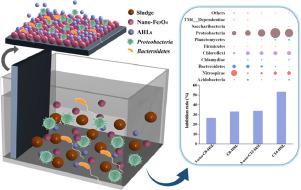Water Research ( IF 11.4 ) Pub Date : 2021-11-25 , DOI: 10.1016/j.watres.2021.117897 Haiyang He 1 , Xiaodong Xin 2 , Wei Qiu 1 , Dong Li 3 , Zhicen Liu 4 , Jun Ma 1

|
This study would investigate the effect of nano-Fe3O4 particles on the performance of membrane bioreactor (MBR), including membrane fouling, membrane rejection and microbial community. It can effectively alleviate membrane fouling and improve the effluent quality in MBR by bio-effect rather than nanoparticle adsorption. The lowest membrane fouling resistance was achieved at R4-MBR (sludge and membrane surface with nano-Fe3O4), which decreased by 46.08%. Meanwhile, R3-MBR (sludge with nano-Fe3O4) had the lowest concentration of COD in effluent which was below 20 mg/L in the stable phase of MBR operation. After applying nano-Fe3O4, the content of extracellular polymeric substances (EPS) and soluble microbial products (SMP) were both reduced with a lower molecular weight. From the microbial community analysis, the abundance of Proteobacteria increased from 25.06 to 45.11% at the phylum level in R3-MBR. It contributed to removing organic substances in MBRs. Moreover, the nano-Fe3O4 restricted Bacteroidetes growth, especially in R4-MBR, leading to a more excellent performance of membrane flux. Besides, the applied nano-Fe3O4 promoted the abundance of Quorum Quenching (QQ) microorganism, and declined the percentage of Quorum Sensing (QS) bacteria. Then, a lower content of N-Acyl-l-Homoserine Lactones (AHLs) in containing nano-Fe3O4 sludge. That was also prone to control membrane fouling. Overall, this study indicates the nano-Fe3O4 particle is appropriate for elevating MBR performance, such as membrane fouling and effluent quality, by bio-effect.
中文翻译:

纳米Fe3O4颗粒在改善膜生物反应器(MBR)性能方面的作用:减轻膜污染和微生物机制
本研究将研究纳米Fe 3 O 4颗粒对膜生物反应器(MBR)性能的影响,包括膜污染、膜排斥和微生物群落。它通过生物效应而非纳米颗粒吸附,可以有效缓解MBR膜污染并改善出水水质。 R 4- MBR(污泥和膜表面添加纳米Fe 3 O 4 )的膜抗污染能力最低,降低了46.08%。同时,R 3- MBR(纳米Fe 3 O 4污泥)在MBR运行稳定阶段出水COD浓度最低,低于20 mg/L。应用纳米Fe 3 O 4后,胞外聚合物(EPS)和可溶性微生物产物(SMP)的含量均降低,且分子量降低。从微生物群落分析来看,R 3- MBR中变形菌门的丰度从25.06%增加到45.11%。它有助于去除 MBR 中的有机物质。此外,纳米Fe 3 O 4限制了拟杆菌的生长,尤其是在R 4- MBR中,导致膜通量性能更加优异。此外,纳米Fe 3 O 4的应用促进了群体淬灭(QQ)微生物的丰度,并降低了群体感应(QS)细菌的百分比。然后,含纳米Fe 3 O 4污泥中N-酰基-l-高丝氨酸内酯(AHLs)的含量较低。这也容易控制膜污染。 总体而言,本研究表明纳米 Fe 3 O 4颗粒适合通过生物效应提高 MBR 性能,例如膜污染和出水水质。











































 京公网安备 11010802027423号
京公网安备 11010802027423号